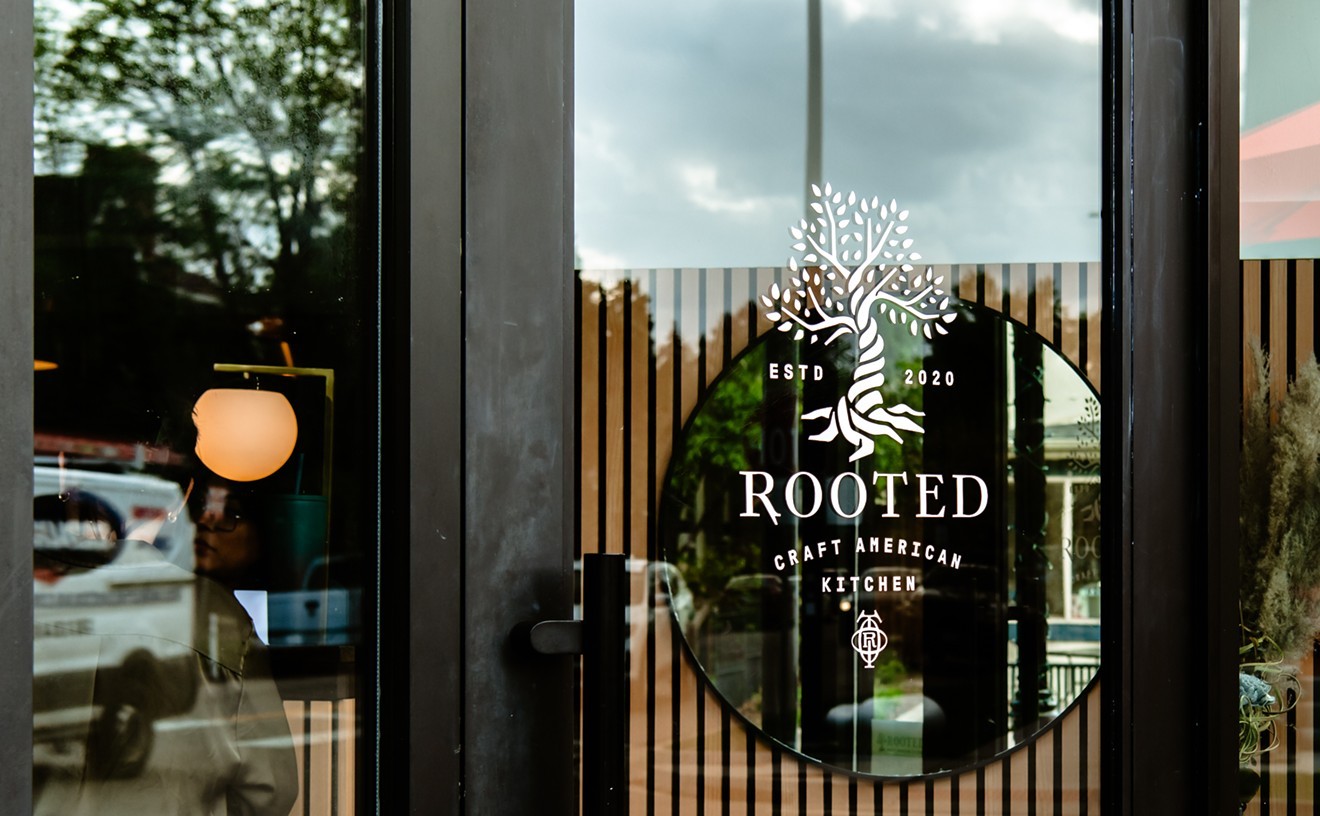Just imagine--and then you should have no trouble deciding what's for dinner.
Although this country's love affair with beef began long before Twain came on the scene, few cities are as enamored of meat as is Denver. And with good reason: We are in the West, where cattle is king, and we're as protective of our steak houses as a cow is of her calf during a stampede. Which is why when an outsider like Ruth's Chris Steak House moves into town, pardner, there's gonna be a showdown--particularly when it stakes out territory only a few blocks from Denver's ruling meat market, Morton's of Chicago (itself an import, but a decade in Denver almost qualifies you as a native). That the three-month-old Ruth's Chris was ready for battle became readily apparent after Rocky Mountain News restaurant critic Bill St. John compared it unfavorably to Morton's; Ruth's Chris fired off a flurry of outraged press releases essentially accusing St. John of being a meathead.
But he was certainly right about one thing: As far as the meat goes, there's no comparison. Morton's is simply the best around, even if the steaks are expensive and the scene is cliquish and the service is snottier than a French waiter is to Americans at Maxim's.
All of which Ruth's Chris was well aware of when it arrived. "Of course, we're going to have to try to do some things better than Morton's," says Rusty Smith, one of three general managers at Denver's Ruth's Chris. "So we're concentrating on service. We're concentrating on a level of comfortable elegance. We want to be a place to relax, where it doesn't matter who you are--you're going to be treated well."
And we were. As at most places where the clientele resembles the cast of The Firm, the decor at Ruth's Chris is stylishly manly and the portions are something to brag about. But while the difference in price between Ruth's Chris and Morton's is small--a few bucks per cut--the difference in taste is huge. This is dry-aging country, but Ruth's Chris sticks with a wet-aging process. As a result, its beef is juicier and more tender but less intensely flavored, with a lighter color and a cruder quality. The cuts, however, are impeccable--all prime, a grade awarded to only 2 percent of meat--and the cooking method makes the most of the wet-aging.
The meat comes to Ruth's Chris from a breaking house in Illinois where, after slaughtering, the sides meet cryovac, the technologically advanced way of aging beef in its own juices. "By the time the meat lands on our dock," Smith says, "it has been wet-aged for about 28 days." According to John Thompson at the U.S. Department of Agriculture, that's seven days over the minimum for quality flavor. "The longer the better, really," he says. "You want to see aging between three to six weeks. That's what softens the connecting tissue, so you get tenderness, and that's what improves the flavor."
So does the fat content, which can be a problem for some customers. "People equate fat with a lesser grade, I believe, and when they come into a restaurant that only serves prime, they think they should get no fat," Smith explains. "Then they order a rib-eye, with its vein of fat, and they think they're getting a cheap steak. But the fat is where the flavor is."
At Ruth's Chris, the steak gets even fatter courtesy a pat of butter, which is slipped onto every cut on its way out of the 1,800-degree broiler. The richness of the butter cuts some of the beef's less refined taste, and the high heat makes for quick cooking--which, despite what you may have heard about searing, is what actually keeps the juices in. Searing provides textural contrast by creating a crust, which I confess I missed at Ruth's Chris, particularly with the hefty New York strip ($24.95). The fact that this is the least tender of the short-loin cuts didn't matter, because here it was as smooth as the butter pooled around it. But despite our specs--which were met--of medium-rare, the strip had a just-killed quality. So did the petite filet ($18.95), eight ounces of tenderloin that, while not the best I've had, certainly wasn't the worst.
The rest of our meals were a big--and I mean big--improvement over the steaks. Twain himself might have found extra food for thought in Ruth's Chris's side dishes and desserts. Of course, Twain wrote his travelogue in the late 1800s, and Ruth Fertel didn't dream of starting her venture, now the largest upscale restaurant company in the country, until 1977, when she renounced her chemistry degree to buy a small New Orleans restaurant called Chris Steak House (hence the awkward name). Today there are 46 Ruth's Chris restaurants, 26 of them franchised. Denver's is one of those; it belongs to restaurateur Marcel Taylor of Las Vegas, where he owns two others. With a handful of exceptions, however, the Ruth's Chris recipes are the same everywhere.
Many of them reflect the Louisiana home of the original restaurant. An appetizer of shrimp remoulade ($7.95), shrimp cocktail Creole-style, came with a remoulade that was not the classic French concoction of mayonnaise with mustard, capers, gherkins and anchovies, but an adaptation created by the Spaniards who governed New Orleans in the eighteenth century. (They called residents of New Orleans with European heritage Criollo, and the combination of Spanish, French and African backgrounds inspired Creole cookery.) This remoulade was not as pungent as the original recipe, but the concoction of oil, vinegar, egg yolk, Creole mustard and garlic stood on its own. Spaniards also contributed to the side of creamed spinach ($3.75)--after all, they brought the plant to this country centuries ago--but at Ruth's Chris the treatment was more Cajun than Creole, with an underlying current of heat and a light hand pouring the cream.
The distinction between Creole and Cajun is crucial to the St. John/Ruth's Chris spat. In his review, St. John wrote that "no Creole I know would recognize the andouille sausage" in the mixed grill ($18.95). And that's true--but a Cajun would. The excellent grill contained filet, chicken and a sausage marketed commercially by Paul Prudhomme, who's about as authentically New Orleans as you can get. But he's not Creole. As it's made in Louisiana, andouille sausage is Cajun all the way, full of chitterlings and tripe and lots of spices. The French influence did make an appearance in the potatoes Lyonnaise ($3.75); the pommes were buttery-soft and paired with slightly caramelized onions inside a thin crusty shell.
No country would claim credit for the Ruth's Chris hollandaise, though. It had the consistency of melted butter and contained too little lemon, and it arrived alongside unevenly cooked tree trunks of asparagus ($7.50). But the absurdity of that side paled when we saw a man at the next table trying to tackle a whole head of broccoli on a tiny plate. In fact, our main complaint about the side dishes was that the portions were too large: Although the waitstaff was quick to point out that they were sharing size and each arrived with a big spoon for serving, there was nowhere to dish them out--except onto our steak plates, already swimming in beef juices and butter.
After so much food, only a suit fresh from a stock-market killing would have had an appetite for one of Ruth's Chris's enormous desserts. The pecan pie ($4.50) was a gooey Southerner, corn syrupy and crammed with nuts. Although the mud pie ($4) wasn't a traditional take on the dessert--the recipe came from Smith--it was fabulous nonetheless, with two layers of Josh and John's ice cream (chocolate-chocolate chip and coffee), two layers of fudge (more, please!), and a thick, chocolate-wafer crust. It was also the largest piece of dessert I've ever seen.
Ruth's Chris makes a big attempt to serve you more than just a slab of beef. Which is smart marketing, because when you compare its steak to Morton's, never the Twain shall meat.










